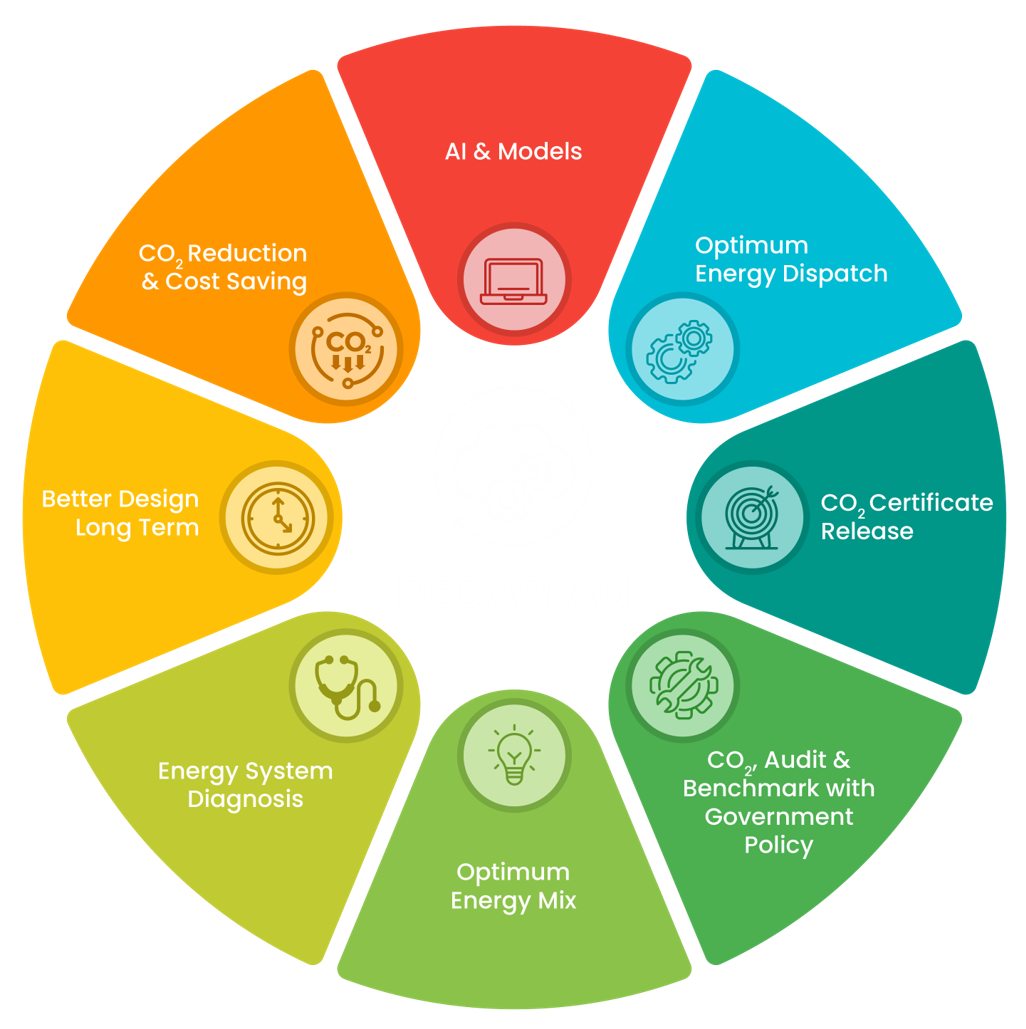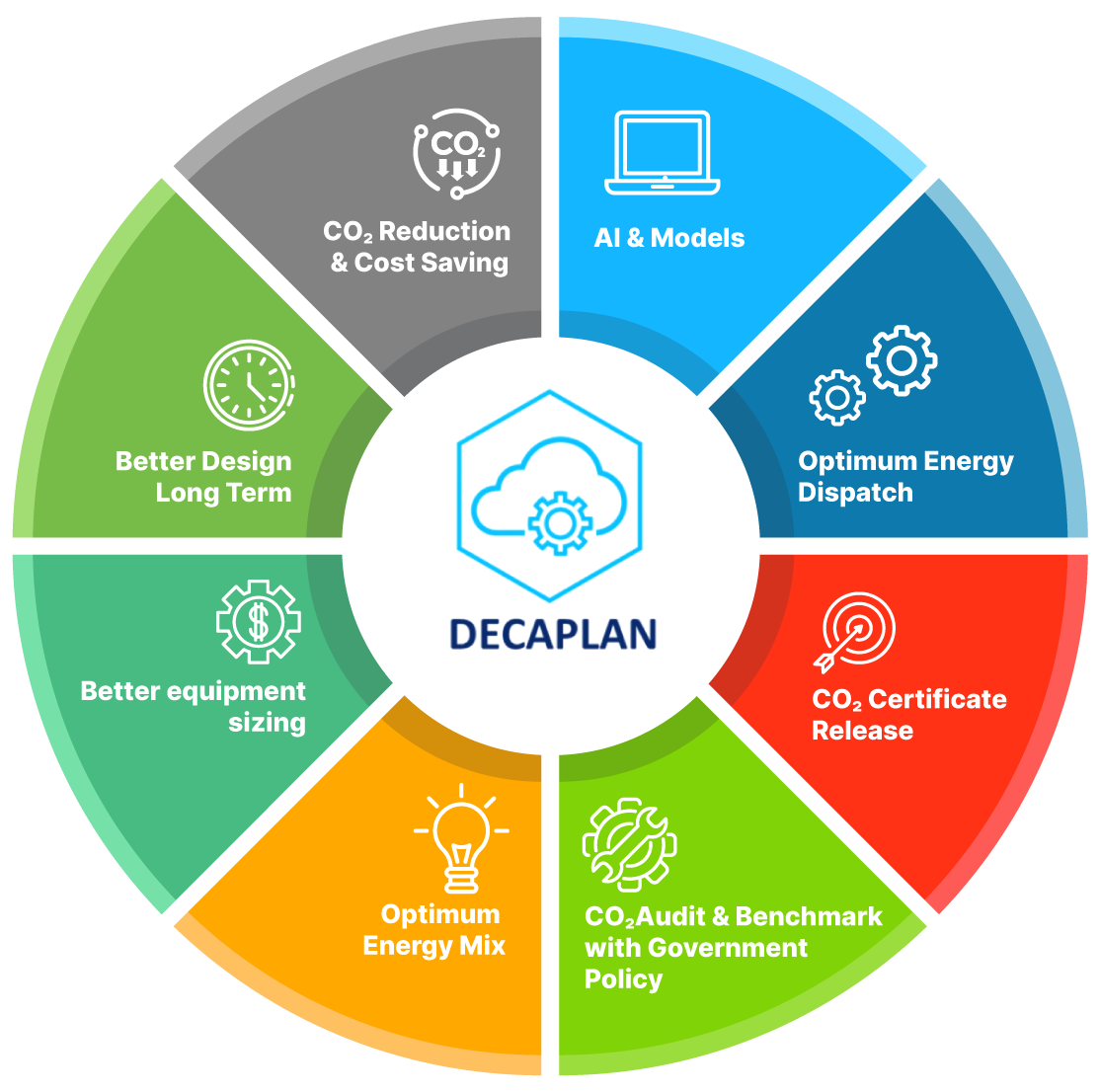Our Digital Platform
Smart Technologies of the Future
DECAPLAN™ Digital Platform

DECAPLANTM is a Unique Energy Modeling and Analytics Digital Platform with High Power, Accuracy and Speed to optimize Global Decarbonization Solutions. With superior capabilities and ease of use, our Digital Platform can help you achieve up to 25% savings in OPEX and to meet your decarbonization targets.
- User-Friendly Interface
- Online & Offline Mode Available
- Fast and Robust Computations
- Easily Customizable
Why DECAPLAN™?

Our Novel Approach to Optimized Design, Operation and Validation & Certification.
Integration and retrofitting of Renewable Energy (no emissions), Combined Cooling, Heat and Power (CCHP) Technologies (Performance improvement) and Storage (electrochemical, thermal, mechanical-optimal operations), and Optimal operations and design.
Possibilities of integration with Net Zero Total Decarbonized Solutions, including fuel diversification (Hydrogen, Biomass) and Carbon Capture and Storage/Utilization solutions (CCS & CCU).
Overcoming Unit Commitment and Economic Dispatch problems for the new configuration, retrofitting and the given layout, including Forecasting, Artificial intelligence (AI) and Machine Learning (ML) solutions.
We help monitor the performance and condition of your systems for optimal maintenance scheduling and operations by integrating Artificial Intelligence (AI) and Machine Learning (ML) and linking them to the Building Management Systems (BMS).

Why DECAPLAN™?

Our novel approach to optimized design, operation and validation & certification.
Integration and retrofitting of renewable energy (no emissions), cogeneration technologies (CCHP & performance improvement) and storage (electrochemical, thermal, mechanical-optimal operations), and optimal operations and design.
Possibilities of integration with net zero total decarbonized solutions, including fuel diversification (hydrogen, biomass) and carbon capture and storage solutions (CCS & CCU).
Overcoming unit commitment and economic dispatch problems for the new configuration, retrofitting and the given layout, including forecasting, artificial intelligence (AI) and machine learning (ML) solutions.
We help monitor the performance and condition of your systems for optimal maintenance scheduling and operations by integrating AI and ML and linking them to the building management systems.
Features of DECAPLAN™
Our AI-Driven Digital Platform
01
Algorithm
Calculations in the DECAPLANTM are performed by adopting different algorithms and the innovative coupling of heuristic & deterministic solvers to simultaneously solve topological (layout & configuration) and optimal dispatch problems.
02
Artificial Intelligence and Machine Learning
DECAPLANTM can establish and predict the building estate or industrial park load consumptions with respect to the geographical location and prevailing weather conditions with Machine Learning for predictive maintenance and asset management.
03
Automatic Adoption of Normalized Component Costs in Database
While manufacturers are reluctant to publicly disclose their systems’ CAPEX & maintenance costs, DECAPLANTM has a normalized cost function embedded in the solver, which can be improved to represent multiple overseas markets.
04
Components Database
For the most realistic and accurate solutions possible, the Digital Platform will integrate a database of components available in the market for the aforementioned power systems components (electricity generators, cooling systems, renewables, energy storage technologies, etc.). The comprehensive database also includes the equipment type, part-load curves, efficiencies and other technical specifications.
05
Integration of Local Code of Practice and Financial Regulations
The Digital Platform automatically integrates local standards and codes to ensure the design and financial compliances to your governing bodies. For instance, the inclusion of a carbon tax and variable electrical grid tariff would influence the system’s selection and configuration.

